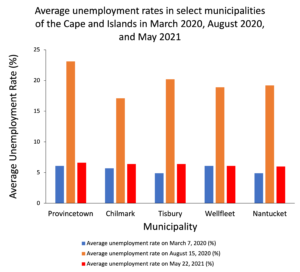COVID-19 and Unemployment Rates in the Cape and Islands
The COVID-19 pandemic has had a large impact on unemployment rates across the United States. Previous analyses of the effects of COVID on employment rates by Gregory Sullivan and Rebekah Paxton of Pioneer Institute have suggested that occupations in the hospitality sector (such as food services, accomodation, arts, recreation, and entertainment) have been heavily affected by the COVID pandemic. Because of the high concentration of these types of jobs in the Cape and Islands, this area has experienced a large increase in unemployment rates as a result of the pandemic. The most current data on unemployment rates in Massachusetts seem to support this claim. Pioneer Institute’s COVID unemployment tracker provides estimates of unemployment rates in Massachusetts. The tracker indicates that the five municipalities with the highest unemployment rates in Massachusetts (as of May 22, 2021) are Provincetown, Chilmark, Tisbury, Wellfleet, and Nantucket (respectively), all located in the Cape and Islands. However, these municipalities may be slowly recovering from these damaging effects of the pandemic.
Provincetown, located at the tip of Cape Cod, currently has the highest unemployment rates of all of the municipalities of Massachusetts. As of May 22, 2021, Provincetown has an unemployment rate of 6.6%. The average unemployment rate of Provincetown was 6.1% as of March 7, 2020 (Figure 1). However, Provincetown also reached its peak for highest unemployment rate on August 15, 2020, with a rate of 23.1%.
Chilmark, located on Martha’s Vineyard, currently has an unemployment rate of 6.4%. At the beginning of the pandemic, the unemployment rate of Chilmark was 5.7% (Figure 1). Chilmark reached its peak unemployment rate of 17.1% on August 15, 2020.
Tisbury, also on Martha’s Vineyard, had an unemployment rate of 4.9% at the beginning of the pandemic (as of March 7, 2020). The unemployment rate of Tisbury peaked on August 15, 2020, with a rate of 20.2%. The average unemployment rate of Tisbury is 6.4% as of May 22, 2021 (Figure 1).
Wellfleet, on the mainland of Cape Cod, currently has an average unemployment rate of 6.1% (Figure 1). Interestingly, this unemployment rate is equivalent to that of March 7, 2020 (before the pandemic). These data may suggest that the unemployment rate of Wellfleet is restabilizing toward pre-pandemic levels from its peak unemployment rate of 18.9% on August 15, 2020.
Finally, Nantucket, an island off of the coast of Cape Cod, currently has the fifth highest unemployment rate of Massachusetts, with a rate of 6.0% (Figure 1). This average unemployment rate is slightly higher than that of March 7, 2020 (4.9%). However, the current average unemployment rate is much lower than Nantucket’s peak rate of 19.2% on August 15, 2020.

Figure 1. A comparison of unemployment rates at the beginning of the pandemic (March 7, 2020), the middle of the pandemic (August 15, 2020), and most recently (May 22, 2021).
While most of these municipalities have higher unemployment rates than listed before the pandemic, unemployment rates seem to be slowly decreasing from when they peaked in August of 2020 in all five of these municipalities. Now, the COVID vaccine is more readily available across the state, which may have an influence on these COVID-driven unemployment rates. According to Pioneer Institute’s COVID-19 Vaccine Tracker, enough vaccine doses have been administered for 120.1% of people who live in Provincetown to be partially or fully vaccinated, 105.7% of people who live in Chilmark and 154.7% of people who live in Tisbury. Additionally, 92.5% of people living in Wellfleet and 97% of those living in Nantucket have had at least one dose of the vaccine, as of May 27, 2021. (Note: percentages may add up to more than 100% because of inaccurate population estimates and due to people relocating to their second homes during the pandemic). It will be interesting to follow how unemployment rates may change, as the majority of people from these municipalities are vaccinated against COVID.
About the Author: Emily Donovan is a Roger Perry Government Transparency Intern at Pioneer Institute for the summer of 2021. She is a rising senior studying Animal Behavior at Bucknell University.



